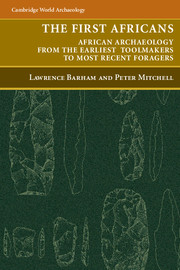Book contents
- Frontmatter
- Contents
- List of Figures and Tables
- Acknowledgements
- THE FIRST AFRICANS
- 1 Introducing the African Record
- 2 Frameworks in Space and Time
- 3 First Tool-Users and -Makers
- 4 Early Pleistocene Technologies and Societies
- 5 Mid-Pleistocene Foragers
- 6 Transitions and Origins
- 7 The Big Dry: The Archaeology of Marine Isotope Stages 4–2
- 8 Transitions: From the Pleistocene into the Holocene
- 9 Hunting, Gathering, Intensifying: The Mid-Holocene Record
- 10 Foragers in a World of Farmers
- 11 The Future of the First Africans' Past
- Notes
- Glossary
- References
- Index
7 - The Big Dry: The Archaeology of Marine Isotope Stages 4–2
Published online by Cambridge University Press: 05 June 2012
- Frontmatter
- Contents
- List of Figures and Tables
- Acknowledgements
- THE FIRST AFRICANS
- 1 Introducing the African Record
- 2 Frameworks in Space and Time
- 3 First Tool-Users and -Makers
- 4 Early Pleistocene Technologies and Societies
- 5 Mid-Pleistocene Foragers
- 6 Transitions and Origins
- 7 The Big Dry: The Archaeology of Marine Isotope Stages 4–2
- 8 Transitions: From the Pleistocene into the Holocene
- 9 Hunting, Gathering, Intensifying: The Mid-Holocene Record
- 10 Foragers in a World of Farmers
- 11 The Future of the First Africans' Past
- Notes
- Glossary
- References
- Index
Summary
Some 73,500 years ago, the eruption of the Mt. Toba super-volcano (see inset) may have helped inaugurate 60,000 years of massive climatic change that incorporated both maxima of the Last Glaciation (Fig. 7.1). At higher latitudes, and especially in the northern hemisphere, the principal impact of those changes lay, as ever, in the realms of temperature and ice sheet expansion. In the tropics and subtropics, on the other hand, the main effect was one of lessened precipitation and greater aridity, even if lower temperatures helped reduce evaporation. It is for this reason that we title this chapter “The Big Dry,” signalling that for the first Africans, the primary challenge lay not in coping with greater cold, but rather in surviving recurrent cycles of drought. The improved, and rapidly improving if still imperfect, accuracy of our chronometric tools makes investigating this question a more attainable goal for The Big Dry than for earlier glacial/interglacial cycles.
How African populations succeeded, or failed, to meet this challenge is among this chapter's themes. Developing topics raised in Chapter 6, we continue to explore the archaeological record for signs of behavioural modernity. Our chronological boundaries are deliberately structured to allow these data to feed into the broader issues raised by the widespread innovation and take-up of microlithic technologies and the transition, or transitions, between Mode 3 and Mode 5 industries.
- Type
- Chapter
- Information
- The First AfricansAfrican Archaeology from the Earliest Toolmakers to Most Recent Foragers, pp. 260 - 307Publisher: Cambridge University PressPrint publication year: 2008



